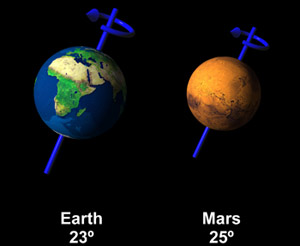Today, September 14, 2011, is the vernal equinox for the northern hemisphere of Mars!
 If you want to be technical, it’s the time when the axis of Martian rotation is perpendicular to the direction of the Sun, and the northern hemisphere is headed into summer (making it the autumnal equinox for the southern hemisphere). When this happens here on Earth, it’s called the first day of spring (here in the US at least, in other countries it’s considered the middle of the season – a tradition with which I agree).
If you want to be technical, it’s the time when the axis of Martian rotation is perpendicular to the direction of the Sun, and the northern hemisphere is headed into summer (making it the autumnal equinox for the southern hemisphere). When this happens here on Earth, it’s called the first day of spring (here in the US at least, in other countries it’s considered the middle of the season – a tradition with which I agree).
Mars, like Earth, is tilted with respect to its orbit around the Sun; Earth is canted at an angle of roughly 23°, while Mars is at 25°. That’s why we (and Mars) have seasons! Over the course of the year, the angle of sunlight hitting the surface of the planet changes, heating it more efficiently in the summer and less in the winter. Boom! Seasons.
On Earth, that’s most dramatically seen as polar ice shrinks and grows over the year. Same with Mars! The picture above is from the European Space Agency’s Mars Express orbiter, and shows the northern polar cap in May 2010, during the last summer. The north pole of Mars is icy, but it’s actually two kinds of ice: water, and frozen carbon dioxide. CO2 turns directly from a solid into a gas (a process called sublimation), and does so at much lower temperature than water ice melts. This means the CO2 goes away first as temperatures rise in the northern hemisphere, leaving the water ice behind. In that picture, the ice is essentially all water.
In other words: the north pole of Mars is sublime*.
Where does the CO2 go? Into the atmosphere! So much of it adds to the air there that the atmospheric pressure on the planet increases measurably, by about 30%. That much extra carbon dioxide adds a small but significant greenhouse effect to the planet as well, warming the surface. Estimates vary, but I’ve seen quotes of a few degrees Celsius for the effect.
The change of seasons also kicks up winds on Mars, and that can cause everything from dust devils which leave incredibly beautiful scrollwork on the surface to planet-wide dust storms.
I’ll note that the year on Mars is about twice the length of an Earth year, so all the seasons are about twice as long as well. May 2010 is when summer started on Mars (in the northern hemisphere), and here we are 17 months later with the start of spring. The Planetary Society has a page listing the next few seasonal dates on Mars if you’re curious.
So anyway, happy first day of spring, Martians! Don’t forget to try to stand up malagor eggs today.
Image credits: Earth/Mars tilts: from Calvin J. Hamilton’s fantastic Solar views website; Mars polar cap: ESA/DLR/FU Berlin (G. Neukum.)
* Hahahahahaha! Man, that’s funny. Also,